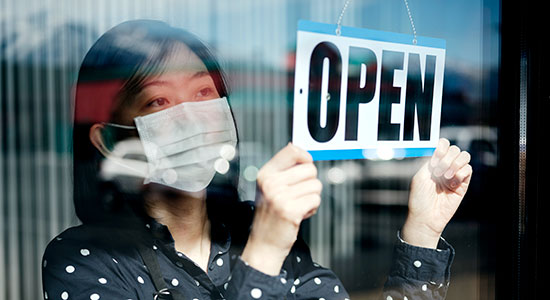
May 20, 2020 – As state and local stay-at-home orders begin to lift, law firms and other businesses and organizations that closed or minimized access to physical office locations in March may be devising plans to bring employees back to the office.
Employers should follow recommended guidance to keep workers healthy and to minimize the risk of claims under statutes such as Wisconsin’s safe place statute, Wis. Stat. section 101.11, which requires employers to furnish a safe working environment.
In a recent interview, Lori Dorn, director of administration for Stafford Rosenbaum LLP and past president of the Wisconsin Association for Legal Administrators (WALA), provided helpful tips for law firms to consider as they bring attorneys and staff back to the office.
She noted that the Wisconsin Economic Development Corporation has developed general and industry-specific guidelines and policies that employers should consult and implement as they ask employees to return to work.
Dorn, who is also the chair of the State Bar of Wisconsin’s Law Office Management Assistance Program (Practice 411™), noted that the Occupational Safety and Health Administration (OSHA) has Guidance on Preparing Workplaces for COVID-19 with recommendations and descriptions of mandatory and safety health standards.
In addition, the Wisconsin Courts COVID-19 Task Force, convened by Chief Justice Patience Roggensack, recently released a final report that “includes a framework to guide counties and circuit courts as they work together to reopen facilities, return to in-person proceedings, and begin to normalize operations,” according to a news release.
<iframe src="//www.youtube.com/embed/Z3YWyOegdoM" width="525" height="295" frameborder="0" allowfullscreen></iframe>
COVID-19 is not going away just because people are coming back to work, says Lori Dorn, director of administration for Stafford Rosenbaum LLP. She shares tips for law firms and other employers to consider when reopening.
Common Questions and Concerns
WALA recently held a roundtable discussion with legal administrators to discuss common questions and concerns, and Dorn addresses many of those in the video above.
 Joe Forward, Saint Louis Univ. School of Law 2010, is a legal writer for the State Bar of Wisconsin, Madison. He can be reached by email or by phone at (608) 250-6161.
Joe Forward, Saint Louis Univ. School of Law 2010, is a legal writer for the State Bar of Wisconsin, Madison. He can be reached by email or by phone at (608) 250-6161.
“They're primarily looking for guidance on how they can keep their clients and employees safe, and how they can comply with the ever-changing orders and regulations and COVID-19-related laws,” Dorn said.
A recent Wisconsin Supreme Court decision curtails the authority of the Wisconsin Department of Health Services (DHS) to issue statewide public health orders related to COVID-19 without legislative oversight, and any statewide approach to reopening the economy in phases appears futile.
Thus, local jurisdictions have released plans with recommendations and guidance for employers. The binding effect of any locally extended safe-at-home order or economic bounce back plan is not clear.
However, all employers should follow guidelines and recommendations for safe workplaces, including appropriate policies and procedures regarding the following:
-
physical distancing and protective equipment;
-
temperature checks and symptom screening;
-
testing, isolating, and contact tracing;
-
sanitation;
-
use and disinfection of common and high-traffic areas;
-
business travel; and
-
other best practices.1
Dorn reiterated that employers should consult resources provided by the Wisconsin Economic Development Corporation, OSHA, and the Centers for Disease Control and Prevention (CDC) to help keep employees safe and minimize liability issues.
“One thing that law firms can do is create a team or committee, or assign an individual within their firm to create a plan and monitor and modify the plan in response to evolving recommendations from the CDC and other health orders that come down from the federal government or state or local municipalities,” Dorn said.
“People realize that this virus is not going away just because people are coming back to work and many firms are contemplating having employees come back on a staggered basis,” Dorn said.
Managing Facilities
Dorn notes specific action that employers should take, such as keeping a log of everyone who enters the office space, including employees, clients, and vendors in order to provide required notifications if a guest tests positive for COVID-19.
Dorn also says law firms should evaluate facility operating systems, such as heating, ventilation, and air conditioning, to ensure air filters are in compliance with rules and regulations. Other tips that Dorn mentions in the video include:
-
Consider elevator usage and policies to ensure social distancing.
-
Talk to landlords about common areas, such as bathrooms shared by other tenants in the building. Consider implementing touchless soap dispensers or other features that allow you to use the facilities without having to touch items.
-
Make sure cleaning crews do a thorough cleaning, preferably every day, and have staff routinely cleaning their office spaces or any common areas, such as break and conference rooms.
-
Consider having one-way hallways to maintain social distance, and place chairs at least six feet apart in conference rooms.
-
Erect physical barriers where possible, such as plexiglass shield at the reception desk, and have a 30-day supply of hand sanitizers, soap, and other cleaning supplies needed to maintain a sanitary office environment
Dorn says there are things law firms can do to make employees and clients more comfortable, but without government mandates, firms will have decisions to make.
For instance, some people may feel more comfortable if they're in an environment with people wearing masks. Without a mandate, employers can strongly recommend that visitors and employees wear masks in an effort to protect everyone. “I think most people would respect that but it's something that firms should be thinking about,” Dorn said.
What about handshakes? “We're so used to doing a handshake, and now we need to think about other ways to warmly greet people when you see them,” Dorn said.
“If a client reaches out to shake your hand, you have a decision. Do you shake their hand and then use hand sanitizer discreetly afterwards? Those are the issues people should talk about.”
What about employee and client screening? “The guidelines from OSHA and the CDC suggest that it's prudent to do so,” Dorn said. She said some firms have decided to do that type of screening. Others will ask people to self-monitor and stay home if experiencing what the CDC has identified as COVID-19-related symptoms.
Finally, Dorn said educating employees on best practices and providing reminders is important, such as reminders on hand-washing and social distancing guidelines.
Webcast: Getting Back to Work When Safer at Home Orders Relax 2020
This one-hour State Bar of Wisconsin PINNACLE® webcast will help employers prepare for the next phase of life in a pandemic. Attorneys Jonathan Eiden and James R. Macy of von Briesen & Roper S.C. in Milwaukee will discuss legal considerations for emerging issues like:
- restarting/recalling employees who have been laid off versus furloughed;
- responding when employees have been exposed to confirmed COVID-19 patients;
- addressing employee apprehension about returning to a physical office
- revisiting and revising remote work policies.
Webcast dates: May 20, May 26, May 29, June 3, June 8, June 12, June 16 (all from noon to 1 p.m.). Reserve your spot.
Endnotes
1 These guidelines were outlined in a statewide plan to reopen the economy with restrictions, in phases. However, Gov. Tony Evers has reportedly abandoned the statewide plan in light of the recent Wisconsin Supreme Court decision that blocked an extension of the statewide safer at home order.
